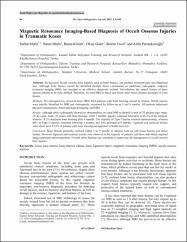| dc.contributor.author | Mutlu, Serhat | |
| dc.contributor.author | Mutlu, Harun | |
| dc.contributor.author | Kömür, Baran | |
| dc.contributor.author | Güler, Olcay | |
| dc.contributor.author | Yücel, Bülent | |
| dc.contributor.author | Parmaksızoğlu, Atilla | |
| dc.date.accessioned | 2020-07-08T13:28:32Z | |
| dc.date.available | 2020-07-08T13:28:32Z | |
| dc.date.issued | 2015 | en_US |
| dc.identifier.citation | Mutlu, S., Mutlu, H., Kömür, B., Güler, O., Yücel, B. ve Parmaksızoğlu, A. (2015). Magnetic resonance imaging-based diagnosis of occult osseous injuries in traumatic knees. The Open Orthopaedics Journal, 9, 84-88. https://dx.doi.org/10.2174/1874325001509010084 | en_US |
| dc.identifier.issn | 1874-3250 | |
| dc.identifier.uri | https://dx.doi.org/10.2174/1874325001509010084 | |
| dc.identifier.uri | https://hdl.handle.net/20.500.12511/5426 | |
| dc.description.abstract | Background: Occult osseous knee injuries, such as bone bruises, can produce persistent pain and functional loss. Although bone bruises cannot be identified through direct examination or traditional radiographs, magnetic resonance imaging (MRI) has emerged as an effective diagnostic method. Nevertheless, the natural history of these injuries remains to be fully defined. Therefore, we used MRI to detect and follow bone bruise injuries secondary to knee trauma. Methods: We retrospectively reviewed knee MRIs from patients with bone bruising caused by trauma. Occult injuries were initially identified by MRI and subsequently rescanned for follow-up at 3 and 9 months. All patients underwent physical examinations, direct radiological imaging, and MRI. Results: Although direct radiographs showed no abnormalities, we used MRI to identify a total of 22 patients (age range: 19–42 years; mean: 28 years) with bone bruising. After 3 months, injuries remained detectable in 68.2% of the subjects, whereas 18.2% displayed bone bruising after 9 months. The majority of Type I lesions resolved spontaneously, whereas 80% of Type II injuries remained following 3 months, and 30% persisted at 9 months. Ligament and meniscal lesions were observed in 63.6% of patients with bone bruising and appeared to hinder recovery. Conclusion: Bone bruises generally resolved within 3 to 9 months in subjects with no soft tissue lesions and minor trauma. However, ligament and meniscal lesions were observed in the majority of patients, and these individuals required longer treatment and recuperation. Overall, these findings can contribute to improving the management of occult osseous knee injuries. | en_US |
| dc.language.iso | eng | en_US |
| dc.publisher | Bentham Open | en_US |
| dc.rights | info:eu-repo/semantics/openAccess | en_US |
| dc.rights | Attribution-NonCommercial 3.0 Unported | * |
| dc.rights.uri | https://creativecommons.org/licenses/by-nc/3.0/ | * |
| dc.subject | Acute Knee Trauma | en_US |
| dc.subject | Bone Marrow Edema | en_US |
| dc.subject | Knee | en_US |
| dc.subject | Ligament Injury | en_US |
| dc.subject | Magnetic Resonance Imaging (MRI) | en_US |
| dc.subject | Occult Osseous Injuries | en_US |
| dc.title | Magnetic resonance imaging-based diagnosis of occult osseous injuries in traumatic knees | en_US |
| dc.type | article | en_US |
| dc.relation.ispartof | The Open Orthopaedics Journal | en_US |
| dc.department | İstanbul Medipol Üniversitesi, Tıp Fakültesi, Cerrahi Tıp Bilimleri Bölümü, Ortopedi ve Travmatoloji Ana Bilim Dalı | en_US |
| dc.authorid | 0000-0002-0022-0439 | en_US |
| dc.identifier.volume | 9 | en_US |
| dc.identifier.startpage | 84 | en_US |
| dc.identifier.endpage | 88 | en_US |
| dc.relation.publicationcategory | Makale - Uluslararası Hakemli Dergi - Kurum Öğretim Elemanı | en_US |
| dc.identifier.doi | 10.2174/1874325001509010084 | en_US |




















